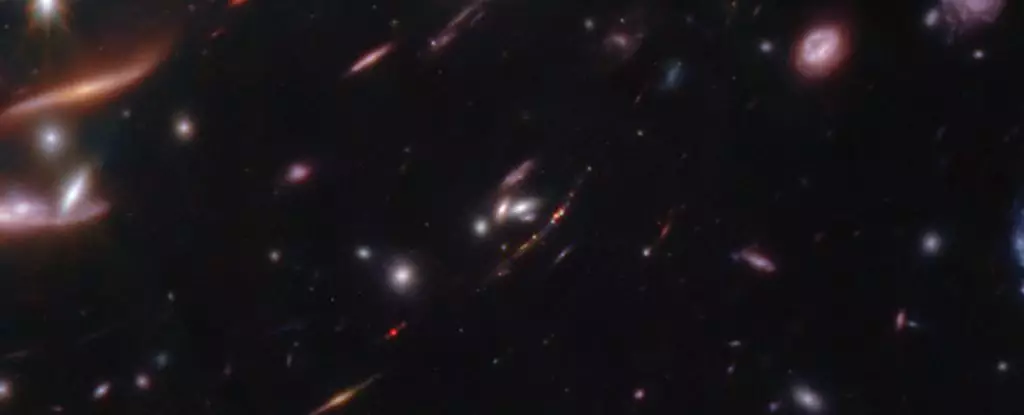In the vastness of the cosmos, a newly observed galaxy, aptly named “Firefly Sparkle,” is shedding light on the enigmatic period after the Big Bang. Nestled in the early universe, a mere 600 million years after this monumental event, Firefly Sparkle offers an unparalleled look at what our own Milky Way might have resembled in its nascent stages. This glimpse into an era characterized by vibrant star formation not only captivates the imagination but also enriches our understanding of galaxy evolution during one of the universe’s most formative epochs—the Cosmic Dawn.
The Cosmic Dawn represents a crucial milestone in cosmic history, marking the time when primordial particles began their intricate dance, ultimately coalescing into stars and galaxies. Firefly Sparkle presents us with a detailed view of these events, highlighting a galaxy actively forming and evolving in the dark stretches of the early universe. The massive effort behind suddenly revealing this distant galaxy stems from the powerful James Webb Space Telescope (JWST) and a fascinating phenomenon known as gravitational lensing, which acts like a cosmic magnifying glass.
Gravitational lensing serves as a key mechanism enabling astronomers to observe celestial objects that would otherwise remain hidden in the dimness of the universe. When a massive object, such as a galaxy cluster, is situated between Earth and a more distant galaxy, its immense gravitational pull warps the fabric of space-time, thus altering the path of light. This bending of light, akin to rolling a marble around a bowling ball on a stretched rubber mat, presents a unique opportunity to see objects that are billions of light-years away.
In addressing the case of Firefly Sparkle, we find it positioned behind a colossal galaxy cluster, which has taken 5.3 billion years for its light to journey through the universe to reach us. By harnessing the JWST’s powerful infrared capabilities, researchers successfully captured the stretched light from Firefly Sparkle. The results were breathtaking—a vivid, intricate image of this early galaxy adorned with sparkling clusters of stars, revealing new insights into the galactic assembly process.
What makes the observations of Firefly Sparkle particularly fascinating is the intricate details they reveal about star formation within the galaxy. Astrophysicist Lamiya Mowla from Wellesley College articulates the surprise at being able to identify ten distinct star clusters emerging from such an early cosmic entity. The diversity in color and brightness among these clusters points towards a dynamic, non-simultaneous star formation process, with each cluster representing a unique stage in stellar evolution.
Furthermore, this reconstruction illustrates not just how stars are forming, but also the mass of this early galaxy. Its estimated mass aligns with what one might expect in a developing counterpart of our Milky Way. The gems of knowledge from Firefly Sparkle allow scientists to piece together not just individual star formation, but the overarching processes that govern the growth of galaxies in the early cosmos.
Astrophysical interactions are not limited to star clusters within Firefly Sparkle. The presence of neighboring galaxies, located at distances of approximately 6,500 light-years and 42,000 light-years, points to an intricate gravitational relationship suggesting potential mergers and interactions. The dynamics that governed these early galaxies could mirror the Milky Way’s developmental history, where smaller galaxies were absorbed in a process likened to cosmic cannibalism.
Astrophysicist Yoshihisa Asada emphasizes this notion, proposing that what we observe in Firefly Sparkle might well be the primordial dance of galaxy formation as they merge and coalesce into larger structures. The gravitational binds established could be early indicators of galactic hierarchies that will lead to the complex universe we observe today.
The examination of Firefly Sparkle offers a rare and unique insight into our universe’s infancy, but it may very well be just the beginning. As astronomer Maruša Bradač remarks, advancements in telescopic technology and methods like gravitational lensing will likely lead to the discovery of numerous additional galaxies from this critical era, paving the way for a deeper understanding of the cosmos. Just as microscopes have unveiled the intricacies of the microscopic world, JWST and its sophisticated lensing techniques are set to unlock the mysteries of early galactic formation, one star cluster at a time.
The cosmos continues to unveil its grandeur, and with each discovery, we step closer to deciphering the ultimate origins and evolution of the universe we call home. The future is undoubtedly bright for those who seek knowledge among the stars.


Leave a Reply